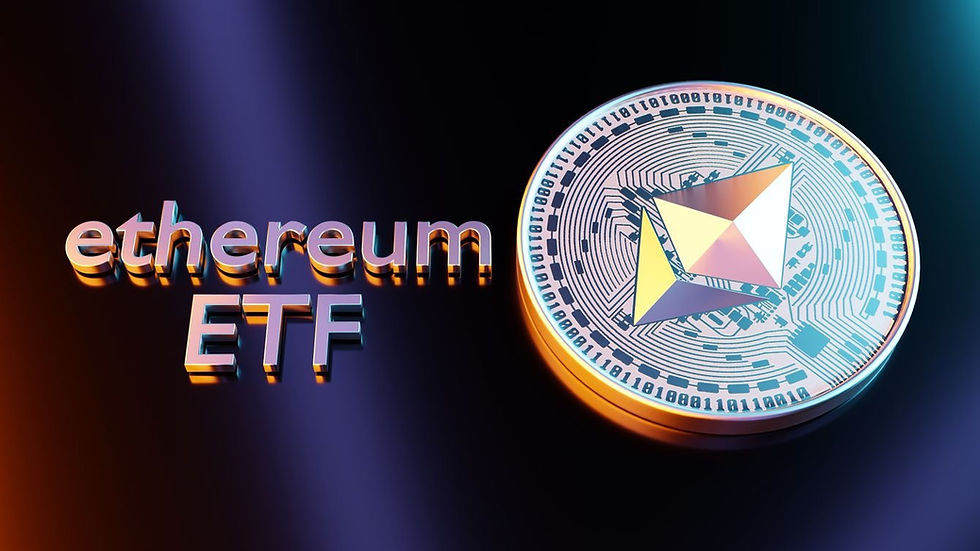Ethereum ETF Investors Face Steep Losses Amid Market Challenges
- Gator

- Jun 1
- 3 min read

Introduction to Ethereum ETF Struggles
Investors in spot Ether exchange-traded funds (ETFs) managed by BlackRock and Fidelity are grappling with significant unrealized losses, averaging around 21%, according to data from Glassnode. Despite recent inflows, Ether’s price has failed to mirror Bitcoin’s upward momentum, leaving ETF investors "substantially underwater." This article explores the factors contributing to these losses, the market dynamics at play, and the potential outlook for Ethereum ETFs.
High Cost Basis and Market Underperformance
Glassnode reports that the average cost basis for investors in BlackRock’s iShares Ethereum Trust (ETHA) is approximately $3,300, while Fidelity’s Ethereum Fund (FETH) stands at $3,500. With Ether’s spot price lagging, these investors are facing considerable losses. Unlike Bitcoin, which has seen robust institutional interest and ETF inflows, Ether ETFs contribute only 1.5% to spot market trading volume, indicating minimal influence on price movements. This disparity highlights Ethereum’s struggle to attract the same level of investor enthusiasm as Bitcoin.
Recent Inflows Fail to Boost Sentiment
On May 29, 2025, spot Ether ETFs recorded net inflows of $91.9 million, with BlackRock’s ETHA attracting $50.4 million and Fidelity’s FETH securing $38.3 million. However, these inflows have not translated into price gains, as Glassnode suggests the ETF market’s impact on Ether’s spot price remains negligible. The lack of significant trading volume and persistent underperformance compared to Bitcoin ETFs underscore a broader market preference for Bitcoin over Ethereum-based products.
Regulatory Hurdles and Staking Delays
The U.S. Securities and Exchange Commission (SEC) has delayed decisions on staking for Ether ETFs, including Grayscale’s Ethereum Trust and Mini Trust, until June 1, 2025. Staking, which allows investors to earn rewards by participating in Ethereum’s proof-of-stake network, could make these ETFs more appealing. However, regulatory concerns about the corporate structure of some staking ETFs, such as those proposed by REX Shares, have raised questions about their eligibility under U.S. securities laws. Despite these setbacks, analysts remain optimistic about eventual approvals, potentially boosting ETF attractiveness.
Ethereum’s Broader Market Challenges
Ethereum’s price has faced headwinds since the Dencun upgrade in March 2024, which reduced network fee revenues by approximately 95%. This upgrade, aimed at lowering user costs, has inadvertently depressed Ethereum’s revenue from layer-2 scaling chains, impacting its economic model. Additionally, Ethereum’s total value locked (TVL) remains strong at $46 billion, but its native token’s performance has lagged behind other cryptocurrencies, contributing to negative sentiment. Glassnode data also indicates that Ether dropped below its realized price of $2,054 in March 2025, a level not seen since February 2023, signaling ongoing market weakness.
Bitcoin’s Dominance Overshadows Ethereum
While Bitcoin ETFs have seen substantial inflows, with $2.75 billion recorded between May 19 and May 25, 2025, Ethereum ETFs continue to struggle. Bitcoin’s institutional demand, driven by major players like Strategy ($427 million in Bitcoin purchases during the same period) and firms like JPMorgan allowing client access to spot Bitcoin ETFs, has solidified its market dominance. This contrast highlights a shift in investor risk perception, favoring Bitcoin’s perceived stability over Ethereum’s current challenges.
Future Outlook for Ethereum ETFs
Despite current losses, there are glimmers of hope for Ethereum ETF investors. Analysts suggest that approvals for staking and in-kind creation could drive renewed interest by late 2025. Additionally, Ethereum’s role as a leading platform for tokenized real-world assets (RWAs), exemplified by BlackRock’s BUIDL fund holding $1.15 billion in Ether, signals growing institutional confidence in its infrastructure. However, for Ether’s price to recover and ETF investors to see gains, analysts argue a sustained rally—potentially to $5,000—would require increased network activity, stronger ETF inflows, and advancements like the Pectra upgrade.
Conclusion
Ethereum ETF investors are navigating a challenging landscape marked by significant unrealized losses and limited market impact. While Bitcoin continues to dominate institutional interest, Ethereum’s potential lies in regulatory advancements and its robust ecosystem. As the SEC deliberates on staking and other innovations, the coming months will be critical for Ethereum ETFs to regain momentum and deliver value to investors.





Comments